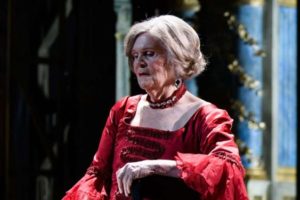

Back on the opera house stage after her WNO debut in Marriage of Figaro back in September (simpler times!), Lisette Oropesa offered audiences a chance to appraise her talents away from a crowded ensemble. Oropesa’s winning stage presence is a natural fit for Marie, and she readily supplied the charisma needed to make this show work. Despite some very involved stage business throughout Marie’s sequences, she kept the physical comedy entertaining while letting the music lead.
If there’s a dramatic quibble to note, it’s that Oropesa’s Act I Marie, played as an irrepressible but still feminine Nellie Forbush type doesn’t quite prepare us for Marie as hopeless fish-out-of-water in Act II. All the farce bits with the music and dancing lessons still work fine, but one doesn’t quite buy that Marie is bewildered by her new surroundings; instead it plays as though she just really likes sticking it to the Marquise.
Skillfully wielding her light, fluttery soprano, Oropesa brought an exciting technical precision to the role (including some formidable trills) as well as a sense of vocal style that ensured the music did its rightful part to convey the comedy. Marie’s two ballads were strong as well, with Oropesa spinning some beautiful dynamic contrasts and applying the steely edge in her voice to mournful effect.
For all of her considerable virtues in this role, however, she perhaps lacks that last mile of vocal glamour that would make this a really memorable turn. That astringent edge in her voice sometimes translated into high notes that registered as accurate but thin and not terribly beautiful, as well as passage work that sometimes sounded colorless and hollow. These issues tended to afflict her solo music more than the ensembles, where soaring full high notes rounded out a series of thrilling climaxes.
Mind you, any minor vocal glamour deficits were handily addressed by the glorious Tonio of Lawrence Brownlee. Brownlee cheerfully conquered the party trick aspects of the role, nailing the dread enumerated C’s in “Ah! Mes Amis” as well as that bonus C# in his big second act number. Brownlee’s appeal extended beyond those calling cards, though, with an urgent melting tone and gorgeous legato lines in moments like the first act duet with Marie and especially a beguiling “Pour me rapprocher.” Character wise, his Tonio is a straightforward affair, with lots of good-natured mugging in Act I and solemn concern in Act II. Mostly one was reminded that, as Donizetti tenors go, Tonio offers fairly meager dramatic possibilities relative to say, a Nemorino.
Elsewhere in the cast, Kevin Burdette provided a strong guiding presence and colorful bass for Marie’s primary regimental father, Sulpice. Recent Domingo-Cafritz alum Deborah Nansteel brought a rich mezzo to the part of the Marquise, though there is perhaps something of a trade-off to casting a younger singer here that needs to work hard to act “old” instead of casting an age-appropriate singing actress who might be better positioned to make something poignant out of this storyline. Timothy J. Bruno, a current young artist who also appeared in the earlier Figaro made another good impression here, lending his booming sound and comic chops to the role of Hortensius.
And of course, no mention of the lineup would be complete without noting that, for this premiere performance only, noted opera lover and occasional supernumerary Ruth Bader Ginsburg did the ceremonial honors as the Duchess of Krakenthorp. The material was a somewhat meandering series of birth certificate jokes and feel-good patter, though the justice had a good bit going with a funny voice every time she said “Krakenthorp.” The audience responded with the ecstatic applause you’d expect for this diminutive 83-year old national treasure who now also happens to be one of the last people standing between us and the abyss. (Perhaps adding to a surreal experience for Ginsburg this week: loyal WNO patron and ornery historical footnote turned potential Secretary of State Newt Gingrich was sitting just beyond the footlights.)
Conductor Christopher Allen led a sprightly reading in the pit, maintaining an easy momentum and largely keeping the big ensemble moments in line. However, as with the Figaro that opened the season, this performance just didn’t feel very polished, and while occasional raggedness isn’t a deal-breaker for this forgiving score, one hopes things will tighten up over the course of the run. The extensive choral writing for the regiment received more exacting treatment from the men of the WNO chorus, prepared by Steven Gathman.
Director Robert Longbottom turned in a warm, easy to digest outing of this chestnut, demonstrating admirable restraint with the farcical aspects (Act II free-for-all excepted, of course). Instead of trying to upstage the music with excessively broad or gimmicky bits, Longbottom generally relied on inventive, natural-feeling details that worked in the spirit of the gentle comedy rather than against it.
The production design sticks to a familiar “alps n’ caps” motif. The first act set (James Noone) makes some interesting use of these materials, with abstract groves of trees flanking a huge oval cutout providing a view onto a quaint backdrop painting of a valley, dramatically lit by Mark McCullough; the generic columned ballroom in the second act is more forgettable. Besides wrangling all those uniforms, costume designer Zack Brown gets extra points for RBG’s shimmery green number and Marie’s fun super wide-legged sailor pants.
Photo: Scott Suchman
























Comments